FORCAST- A Future Prediction System of 2040
A Design Fiction Project created as part of the Trends in Interactive Technologies course - Jan 2020, IIT Bombay
Under Prof. Venkatesh Rajamanickam and Prof. Jayesh Pillai
IDC School of Design, IIT Bombay, India
Abstract
Prediction is a part of our lives. They are based on our learnings and experiences of past and present. The way predictions are done has substantially modified over the past years, specifically, with the introduction of artificial intelligence and big data. Prediction systems like weather forecasts are a reliable source for all of us. Today, they are accurate and acceptable by the large public in general, unlike the past when making true predictions was related to paranormal beliefs. Such belief still persists in our society. But what about the future? Will the methods of future-telling based on paranormal belief exist in years ahead or our technical systems can become more advanced. This report talks about Forecast, as one such system that may be born with the escalation of technology capabilities to make predictions that have logic behind.
Introduction
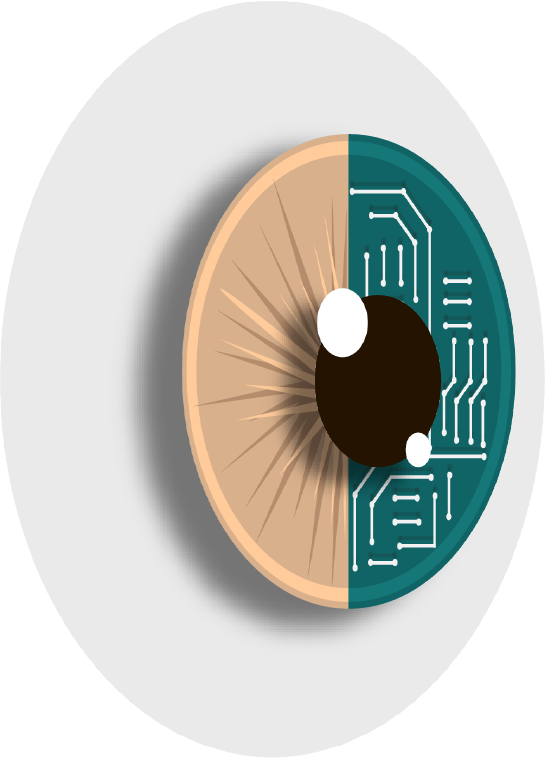
All of us can relate to the term ‘Prediction’, we predict things around us, oneself, and things inside. Humans are good at predicting the future whether it turns true or false, we all predict and so did people from the past. One great example is Michel de Nostradamus from the 16th century, a French physician and astrologer. He has written quatrains(four-line verses), grouped in centuries(100), that are believed to be the prophecies of the future. His enthusiasts regard him to be the predictor of some major events like the French Revolution, the rise of Adolf Hitler, and 2001, September 11 attack. Robert todd Carrol, writer of ‘ The Common-Sense Philosophy of Religion of Bishop Edward StillingFleet 1635-1699’ in one of his articles, on Nostradamus bought together views from other philosophers and doubts on interpretation of quatrains put forward by skeptics that are logical enough. Predictions today are based on patterns from the huge data of past and present. So, as we are moving towards technological singularity, we can predict now, that the ways of prediction and accuracy of prediction in the future will revolutionize and increase respectively.
What-if Scenerio
What if the technology becomes smart enough to predict the possible unknown futures and suggests ways to change an unwanted future?
Trends that lead to this scenario
1. People hold a belief in fortune-telling
Fortune-telling is a part of society with a huge following and is defined as an act of predicting the future. It is rooted in our culture, be it prediction by the oracles of Greece or Akashwani in Hindu mythological stories. In psychology, future-telling is related to other paranormal beliefs, the reason may be the methods and ways they are practiced. Benjamin Radford, a writer, investigator, and skeptic in one of his articles, ‘Future-telling: Fact, Fiction & Fantasy’ wrote ‘Whatever form the future- telling takes, the basic process remains the same that is seeking meaning in random patterns and phenomenon.’ Further, he gives a valid point that the predictions by different practices of future telling are never coherent.
The important part to note is that we humans still believe in fortune-tellers, giving it a firm base. We check horoscopes in newspapers, visit cartomancers, palm readers, or crystallomancy readers. But today we have some modern ways. Play Store and App Store are flooded with future-telling applications with more than 1M downloads but with the same old belief.
2. The predictive strategy of reading
Predicting strategy in reading can be defined as a strategy used by readers to predict what will happen next in a story. This can be based on a book cover, title, book illustrations, what has already been read, experience, and knowledge.
Predication making is important. In an article by Eileen Bailey, ‘Making predictions and reading comprehensions’ she wrote that predictive strategy can involve students and increase their interest level, it makes them question text, understand, recall and help keep a check on their own learnings.
3. Artificial Intelligence
The term artificial intelligence was first coined in 1956 by John McCarthy as the science and engineering of making intelligent machines. AI agents can perform tasks that humans can. They can perceive the environment, recognize patterns, and maximize their success.
It is important to know where today in this world, AI exists. AI is said to be omnipresent. Consider for example google assistant, Amazon’s Alexa, Apple’s Siri, face detection and recognition systems, browsers suggestion for sites, and games. AI is all around us.
AI at its current stage is considered to be a ‘narrow AI’, since it can do very limited tasks for which it has to be trained. A Natural language processing system is not good at cooking. Or a self-driving car cannot surgically operate a human in hospital. ‘General AI’ can be multitasking like humans but it has not yet arrived. Nick Heath in one of his articles about Artificial Intelligence, mentions a survey conducted by four groups of experts. This was done by Vincent C Muller and Nick Bostrom in 2012/13. They reported that there is a 50% chance that AGI(Artificial General Intelligence) will arrive by 2040 and 2050.
Today AI systems undergo supervised learning, unsupervised learning, or reinforcement learning. According to an article by Silke Otte, Chief marketing officer of Innoplexus,- machines can learn from their experiences, and machine learning allows the system to analyze and self improve. Intelligent machines can self educate themselves, an ANN(artificial neural network) allows the system to take multiple inputs and produce an output similar to how a human's Neural Network works. They can understand human languages through natural language processing. With image processing, computers have methods to detect and recognize images and video inputs, giving these systems a vision called computer vision. Further cognitive computing allows better human-computer interaction.
4. Technological singularity is near
Some AI optimists believe that the technological singularity is near and expected to arrive in 2045. It defines a hypothetical time when there will be an intelligent explosion and AI will be recursively making itself smarter than ever before.
The term singularity was coined by John Von Neuman. And Vernor Vinge in his article ‘The Coming Technological singularity: How to survive in the Post-Human Era ’ sponsored by NASA Lewis Research Center and the Ohio Aerospace Institute, March 30-31, 1993 defines Technological singularity as ‘ a point where our models must be discarded and a new reality rule. As we move closer and closer to this point, it will loom vaster and vaster over human affairs until the notion becomes a commonplace. Yet when it finally happens it may still be a great surprise and a greater unknown.’ So the future orientation made in ‘Age of Ultron’, by Marvel studios of AI systems planning to clear the human race from the earth can be a future or as said by Vernor, ‘a future that is something above the definition of good or bad’. Probably when Asimov’s three laws still hold in the future, the human race can survive. But there are believers who agree and state that the singularity may never be near.
5. IoT is expanding
In an article by Margaret Rouse, she defines IoT as ‘a system of interrelated computing devices, mechanical and digital machines, objects, animals or people that are provided with unique identifiers (UIDs) and the ability to transfer data over a network without requiring human-to-human or human-to-computer interaction.’ Gartner in August 2019 did a prediction that the enterprise and automotive IoT market will grow to 5.8 billion endpoints in 2020, a 21% increase from 2019. Consider a future when all devices around us are IoT enabled and do what we ask them to do or they start studying our behavioral patterns to meet our requirement without a request made. Consider for example a smart chair that brings changes in itself based on how you sit, for how long you sit, your body movement- your behavioral pattern of sitting. Kashmir Hill is the deputy editor for the Special Projects Desk, which produces investigative work across all of Gizmodo Media Group's web sites. She writes about privacy and technology. In “the house that spied on me”- Gizmodo, 2018 article, she brings stats from a smart home. She converts her house to smart home to monitor herself and family. Different smart devices were installed in the house and were connected over a network. The devices were collecting data and those data from all devices had a lot to tell about their families’ living patterns.
6. Big data and data analysis
Big data is defined as a huge amount of data. This data can be structured, unstructured, or semi-structured and is continuously increasing. It is characterized by 4 V’s, volume(large amount), variety(variation in data from different sources), velocity(rate of generation of data), and variability(change in the meaning of data). Big data allows ways to analyze and extract information from complex datasets. According to an IDC(International Data Corporation) white paper- ’The data-driven world will be always on, always tracking, always monitoring, always listening and always watching- because it will be always learning.’ It stated that there will be around a 61% increment of worldwide data from 2018 to 2025(175 ZB). Out of which 90ZB will be from IoT devices and 30% of which will be consumed in real-time.
From 2024 to 2025 there will be a 33% increment of data. If we assume it to be the constant rate of increment of data for the next 15 years and is compounded annually-
Total data= 175(1+33/100)^15= 12 K
There will be about 12K ZB of data or more than this because the actual rate of increment of data is not constant, but itself increasing.
7. Cloud computing
With cloud computing, no system is limited by the local space or power.
8. Predictive analysis
Predictive analysis is a technique that is used to predict unknown future events. It harnesses the power of data mining, machine learning, and predictive modeling. Data mining allows the recognition of patterns in data by analyzing it. Predictive modeling uses statistical data to predict outcomes. But the correctness of predictive analysis depends on the quality and quantity of data available.
Hardware is getting better day by day, smaller, reliable, compact, and portable. Mike Alger bought up the idea of an operating system in a VR environment. VR and AR are a reality today and XR is the future. Such a technology does not take a physical space but has generated a concept of virtual space. Alan Turing in 1950 came up with the idea of the Turing test. It is a method that can test the intelligence of a machine. Alan Mathison Turing was a mathematician, philosopher, and a computer scientist. In this test, an interrogator teletype interacts with a machine and a human from two different rooms. Now the interrogator has to find out which one is the machine and which is the human. There were lots of controversies over this test and several modifications were made. So, much importance is given because this is what we humans thrive to achieve. The computer network is expanding and endpoints are increasing. The computer no longer is limited to an interaction of yes and no. With fuzzy logic in place, we have smart washing machines. By putting future-telling, predictive methods and the development in the technology, if we have enough data about everything from machines around us to data about ourselves, it is possible to predict about when one will wake up in the morning, when and who is about to come to your house, how well a student will perform in a test, a crime before it happens, etc.
When in the future is this scenario
The scenario is proposed for 2040, 20 years from now. The selection of the year 2040 is based on the prediction that technological singularity is near and may arrive by 2045. Since in this scenario, machines are still in the hands of humans, some year a little before 2045 was considered preferable. Further based on the report of Vincent C Muller and Nick Bostrom about the arrival of AGI(Artificial general intelligence) by 2040, this year was selected for the existence of this scenario. It requires at least one system to be intelligent enough to talk, understand humans, know about the world around, know how the world affects the user and those with whom the user is connected. Figure 1 shows why 2040 is proposed for the existence of this scenario.
Design fiction world
Forecast portrays a world where people have their own assistant bots like Tony Stark’s J.A.R.V.I.S, (just a rather very intelligent system) in Iron man and Avenger’s stories. These assistant bots are called Assistant Vision. Unlike a moving machine that walks beside you, these assistant vision come as a set of ear wearable, hand- band, eye lens and an operating system. So the entire system provides one with cybernetic eyes, monitors human fitness, talks to them, does what they ask the bot to do, knows most about the particular user, and has an extensive reality user interface.
Figure 1
In this world, Forecast is a service delivered only to the paid members via the Assistant Vision platform. It is the leading firm of 2040 and allows their customer to know about their future. They can check the percentage probability of the occurrence of an event in the future. This application even allows users to check the percentage probability of an event and ways or methods to change them.
Other specific details of the context
The scenario has many specific details and further scenarios that can be built around it. They are not dealt with in this report but it is important to list some of them.
1. Privacy concerns?
2. Changing of the future may not be possible!
3. Actions of multiple users affect the same future and they all try to change one future prediction, in different directions.
4. When?- Comes -When?- Get served(FCFS/ LCFS), whose action will affect a prediction the most, one who comes first and takes an action to change it or one who comes last and takes action to change it or is there a better method to handle this?
5. Hacking of futures?
6. Prediction about a prediction can be a new topic.
7. Astrological stake?
8. Can the concept of religion apply to this?
9. Today future-telling is associated with paranormal beliefs, will it still hold in the future?
10. The emotional effect on humans?
11. The requirement of proper laws to control such systems.
12. Some panic mode controllers(physical/sensory) are required if a person gets to know something unexpected.
13. A system that tells- “if you want to achieve this- do this”? It should help to achieve a goal.
14. A threshold point to which something about the future should be told. This is critical and worth considering. Example- can someone be told that he/she is about to die?
Diegetic Prototype
Each diegetic prototype is considered to be an entry point to the future world proposed. To better experience the scenario of ‘prediction of unknown futures’ in 2040, a set of prototypes is designed.
1. Assistant vision (a personal assistant for all humans in 2040)
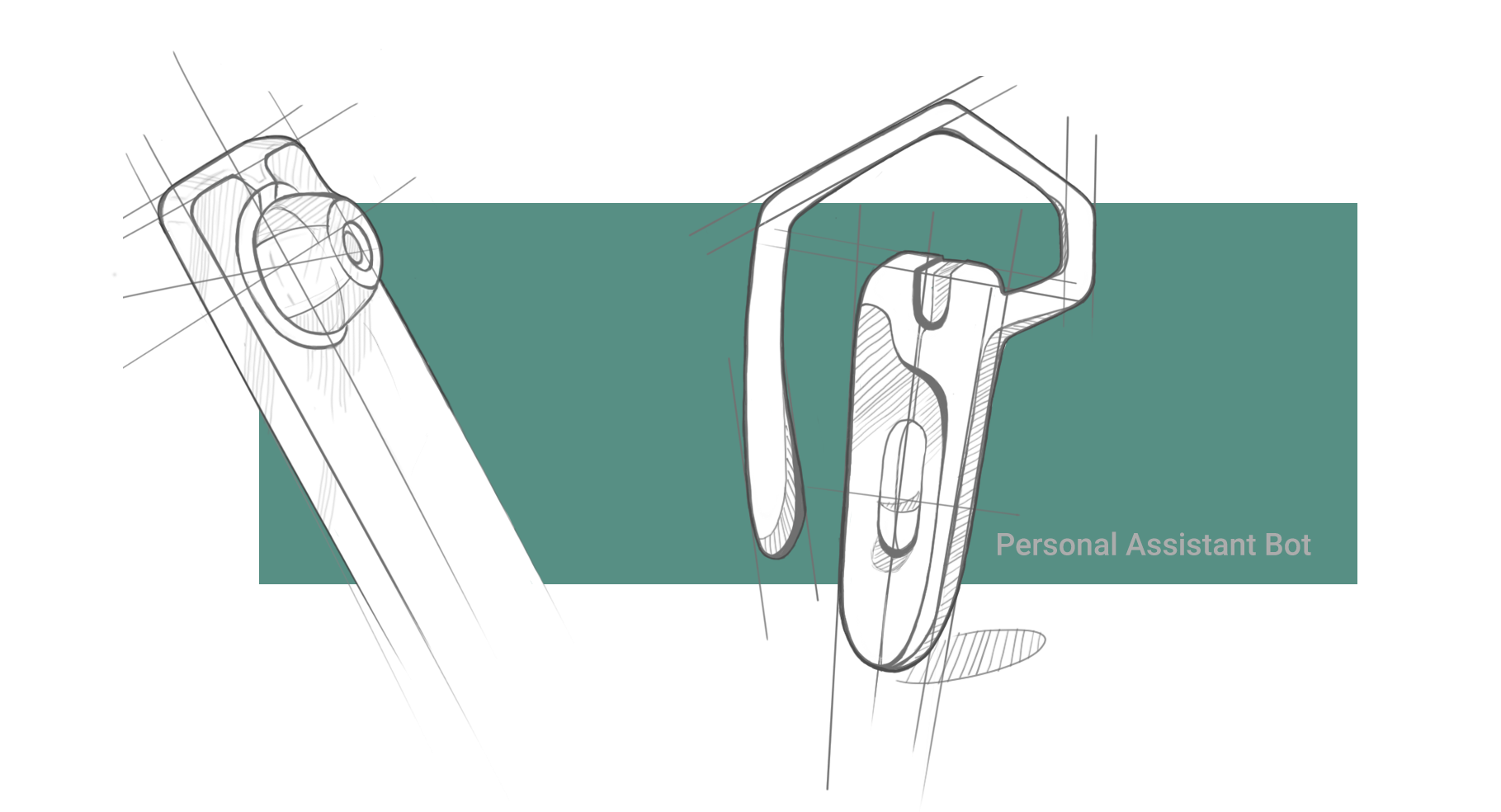
Figure 2
Assistant vision is the assistant bot of 2040 that delivers personal assistance to each individual. It consists of a set of wearables. These wearables allow the assistant bot to talk to their human masters, keep track of their health and day to day activities. Figure-3 and 4 show the design of the ear wearable, a part of Assistant Vision wearables. Figure-8 shows how human-computer interaction will be assisted by assistant vision. The girl in the picture is wearing the Assistant vision ear-wearable and her eyes are cybernated. These cybernetic eyes enable humans to have their personal XR environment incorporated with an operating system of the future. This entire system together makes the Assistant vision that helps humans in their personal digital space. It allows them to virtually attend a class, meeting, party, or work online, check weather reports, receive health-reports, control remotely situated systems, obtain advice, contact friends, etc. The forecast is a service delivered via this platform to allow humans to check possible futures and percentage probability to change them.
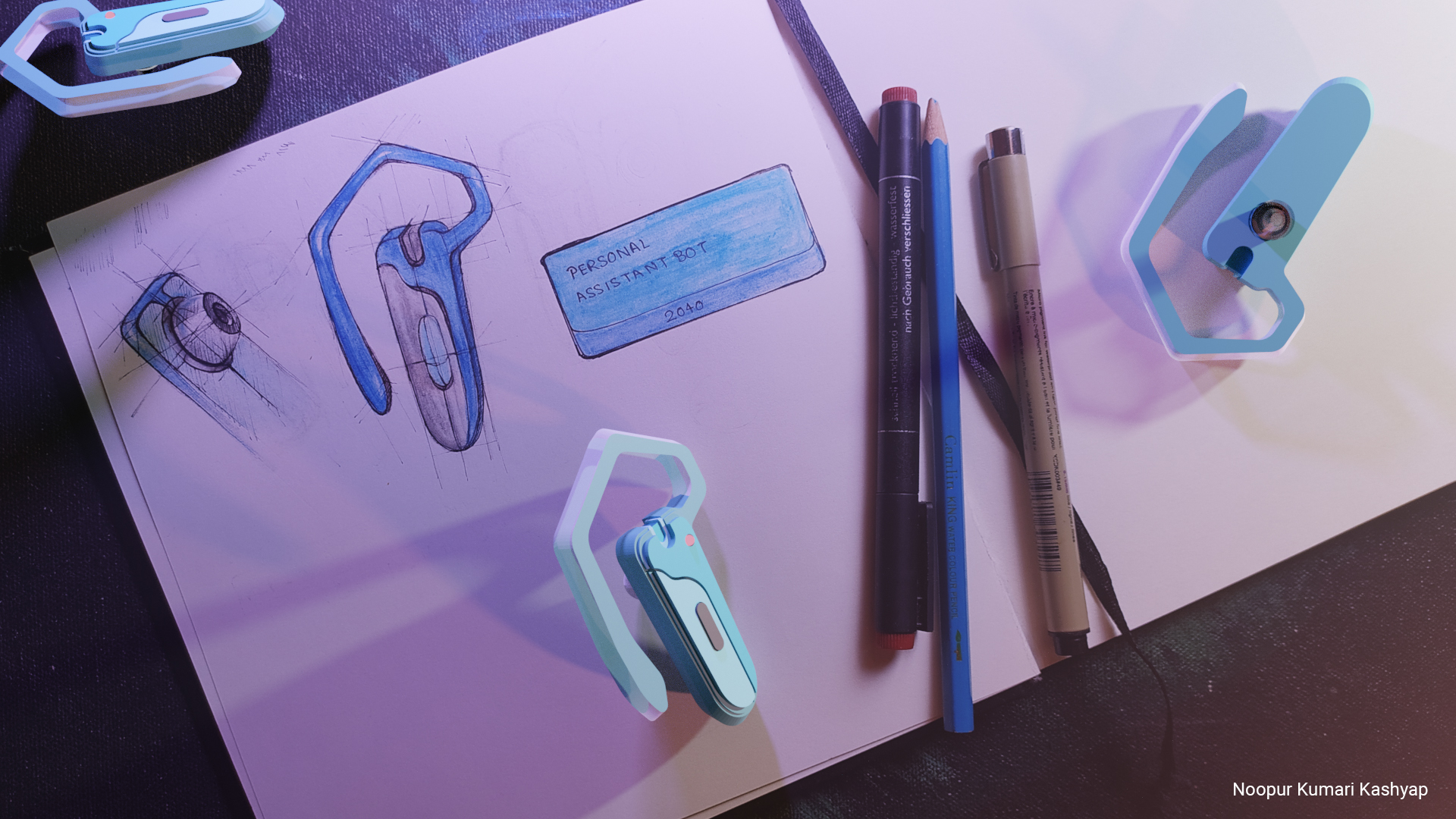
Figure 3
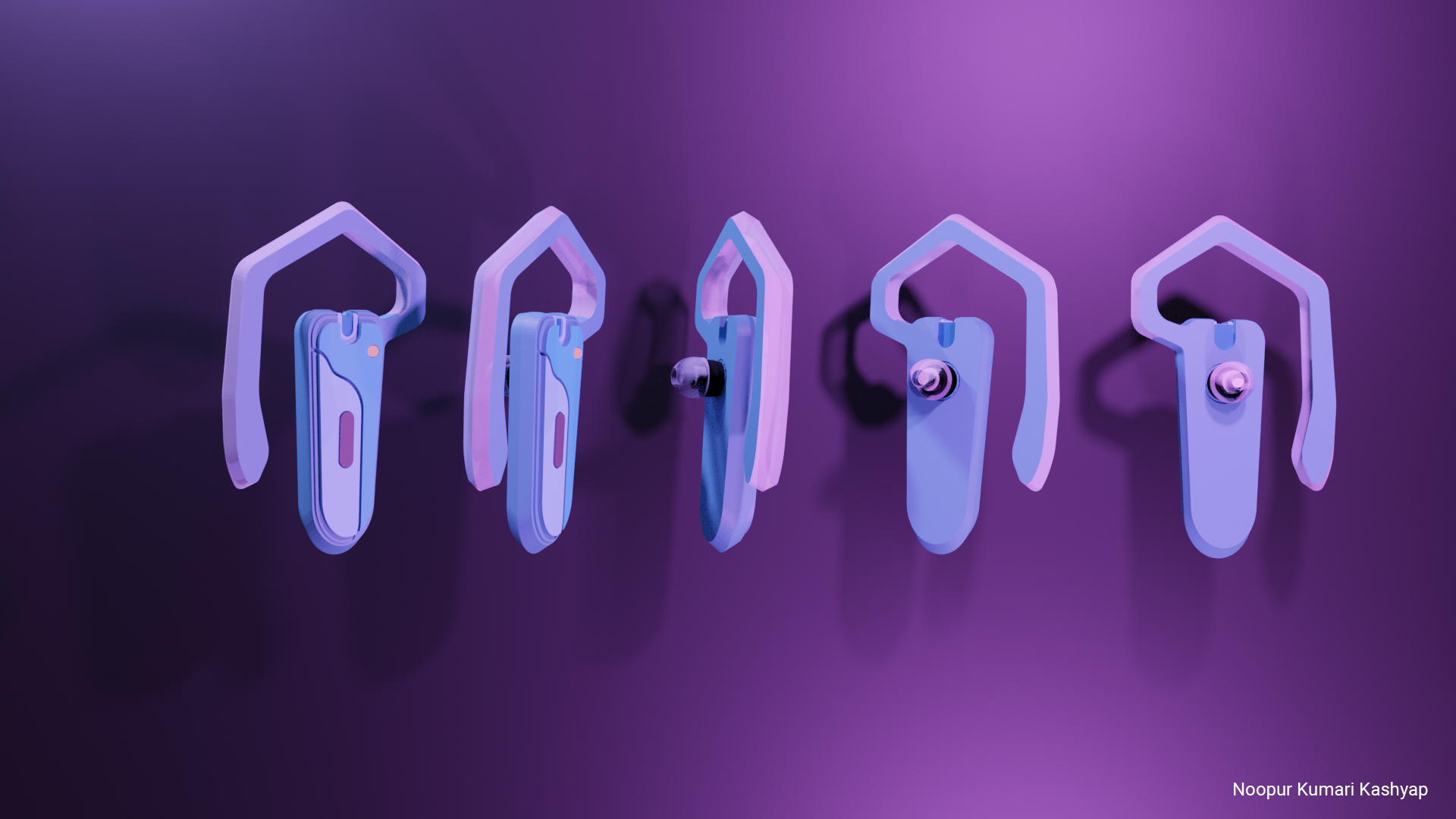
Figure 4
Figure-5 shows, how the ‘future prediction system’ works with an Augmented-Reality based Assistant bot. The application provides details and predictions of interest, of an object or human in view of the person equipped with the Assistant bot wearables. In figure-5(a) the system predicts rainfall in 2 hrs 36 mins. As the person in view must complete his painting before it rains, the system predicts a 74% probability of completion of the painting before it rains and steps to increase the percentage and help him complete before it rains. In figure-5(b) when apples kept on a table is viewed, the system gives 81% probability that the prices of apples will double in the next 2 days and suggestions to make an order that day. Figure-5(c) shows a person named Sara Karling in the view of a person. Sara stood for election that year and the system tell about the percentage probability of her winning the election. The system predicts that there is a 68% chance that she will win the election. This prediction of the system is based on 70% of people talking about her and the views in her favor. It also suggests little steps that can change her probability of winning like making a tweet. A tweet can change her probability of winning by up to 2%(either increase or decrease). Since she is unknown to the user, the system also gives information about this public figure available online.
.jpg)
(a)
.jpg)
(b)
.jpg)
(c)
Figure 5
2. Forebot (a smart robot manager of Forecast)
Forebot is the chief operating manager of Forecast, the future prediction system of 2040. The look and appearance of the forebot is shown in figure-6 and 7. It is designed and rendered in Blender 2.8. This robot is a manager by profession and shows the close co-existence of robots and humans in the coming future. It also shows that machines will become smart to a level, to compete with humans. The robot does not look like a human to maintain the difference between the two and their intelligence. Such an existence of humans and robots together is based on the prediction about the arrival of the technological singularity.
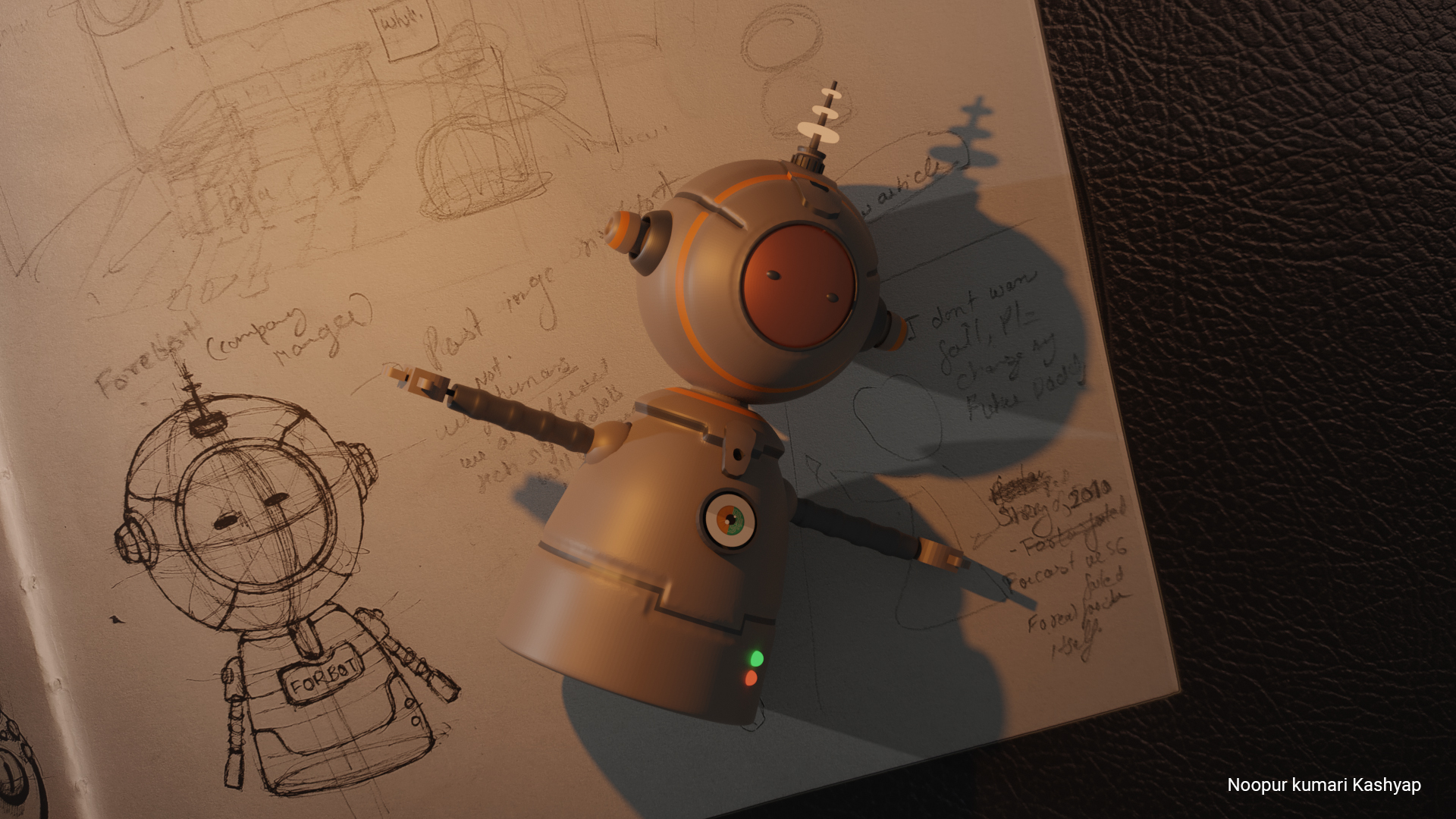
Figure 6
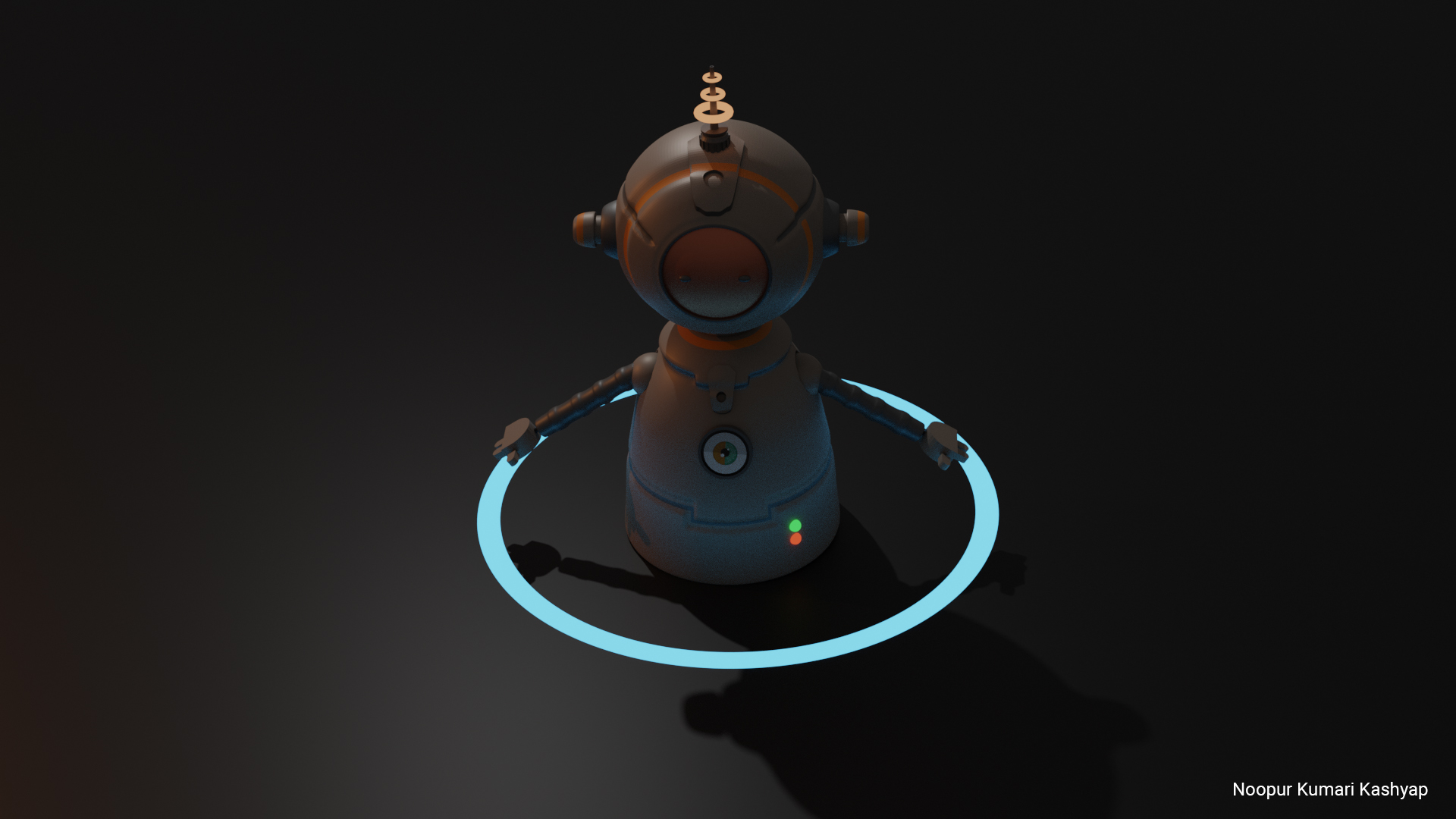
Figure 7
3. Interactive VR experience script
Before writing the script, a survey form was floated. The number of participants’ responses were 13 within the age group of 24 to 28 years. The survey was conducted with the fathers of 2040. People of the above age group will be around 45 years in 2040 and preferably fathers around that year. The survey was conducted to understand what will they do if they come to know that their 10 years daughter will fail in an exam a day later, will they prefer to have suggestions from a smart system as to what to do. They were asked to imagine themself to be the CEO of Forcast and one day they come to know that their daughter will fail the next day. Some said that they w ill teach the daughter, others said that they will let her fail, and yet others said that they will let her face her fate or follow the suggestions of the bot. But some interesting answers preferred using the powers of being the CEO, like sending false predictions to school to let them postpone the test. The insight obtained was that knowing the future that may come, these people,- the future fathers, were ready to act on it to change it.
4. AR news as an extension to the VR script
Figures 8 and 9 show Anna, daughter of Mr. Wishler. This character was designed in blender 2.8 following the process from sculpting to rigging. As per the VR Script above a prediction is made by Version 5.6 of the future prediction system that Anna will fail in the coming exam to his father, Mr. Wishlur while he was testing this version for the first time. But soon after this prediction, this trial version crashes. And version 5.5 after the trial of version 5.6 predicted the failure of version 5.6 with an ever seen probability of 98.99%. Now the problem is, which prediction to believe because if one holds true another does not.
.jpg)
(a)
.jpg)
(b)
.jpg)
(c)
.jpg)
(d)
Figure 8
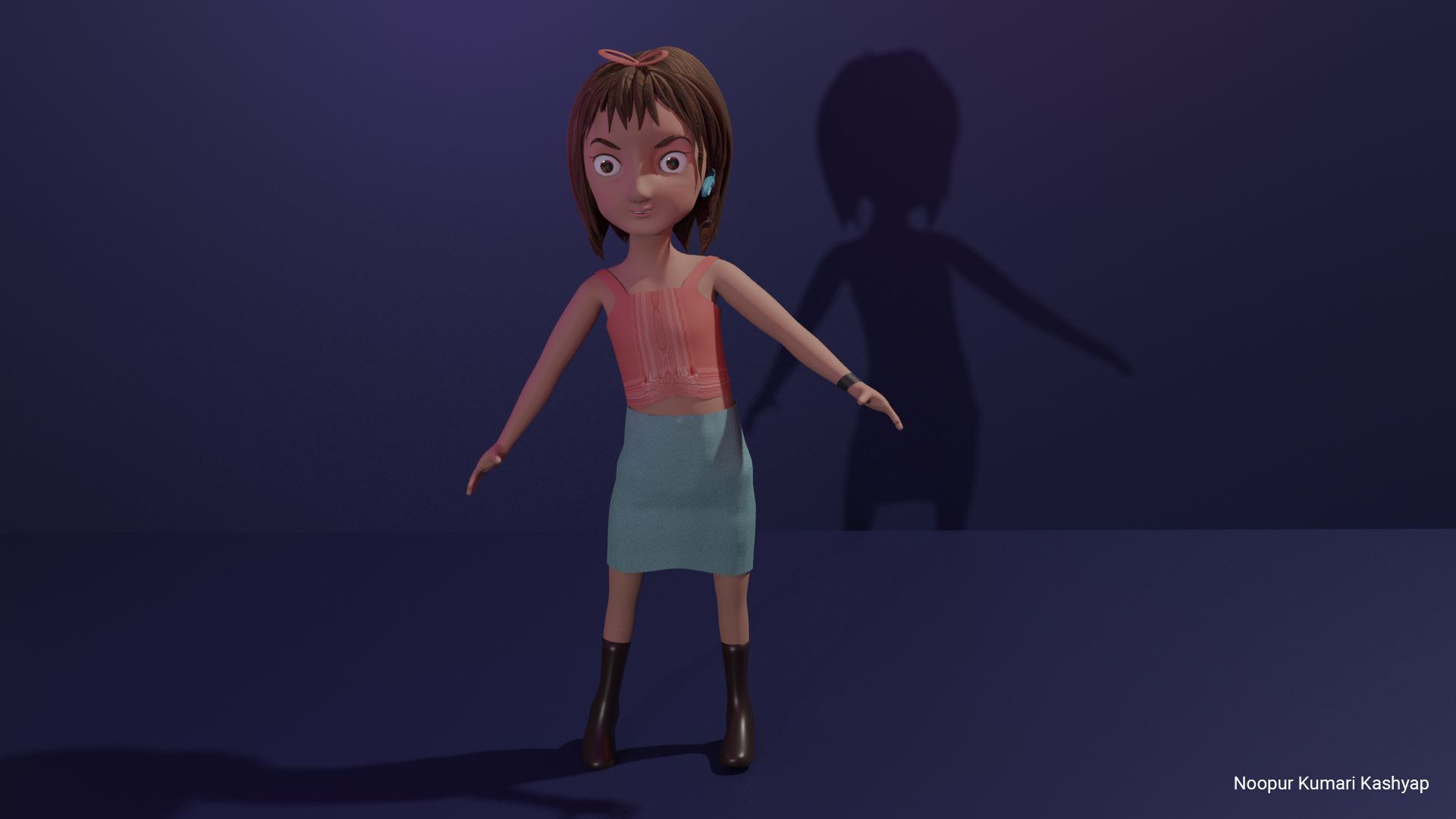
Figure 9
Figure 10 depicts the prediction made by version 5.6 about the failure of Anna in her coming exam. Figure 11 shows a poster created as an extension of the VR script. This poster represents the final incident of the VR script and the confusion it brings.
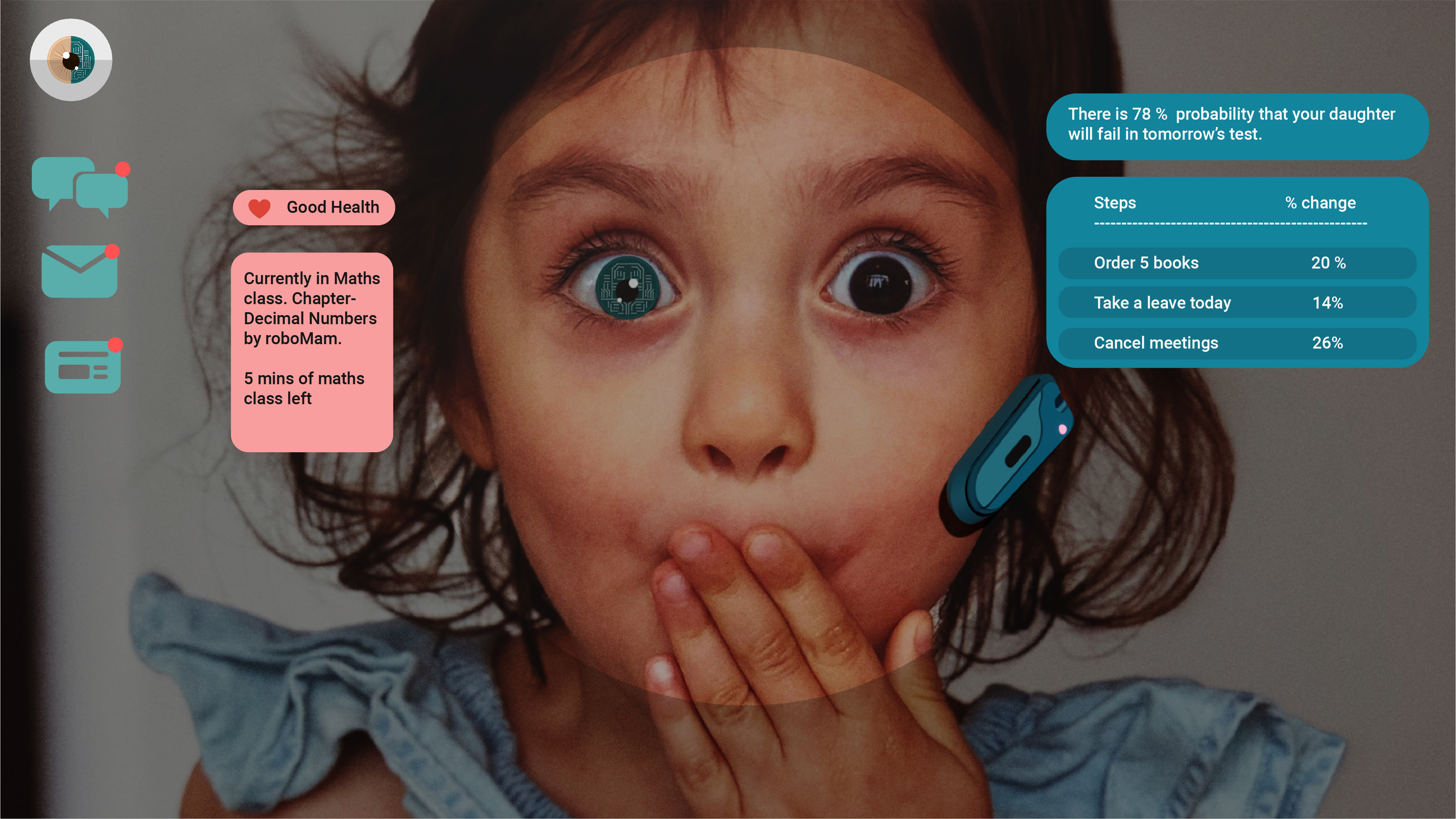
Figure 10
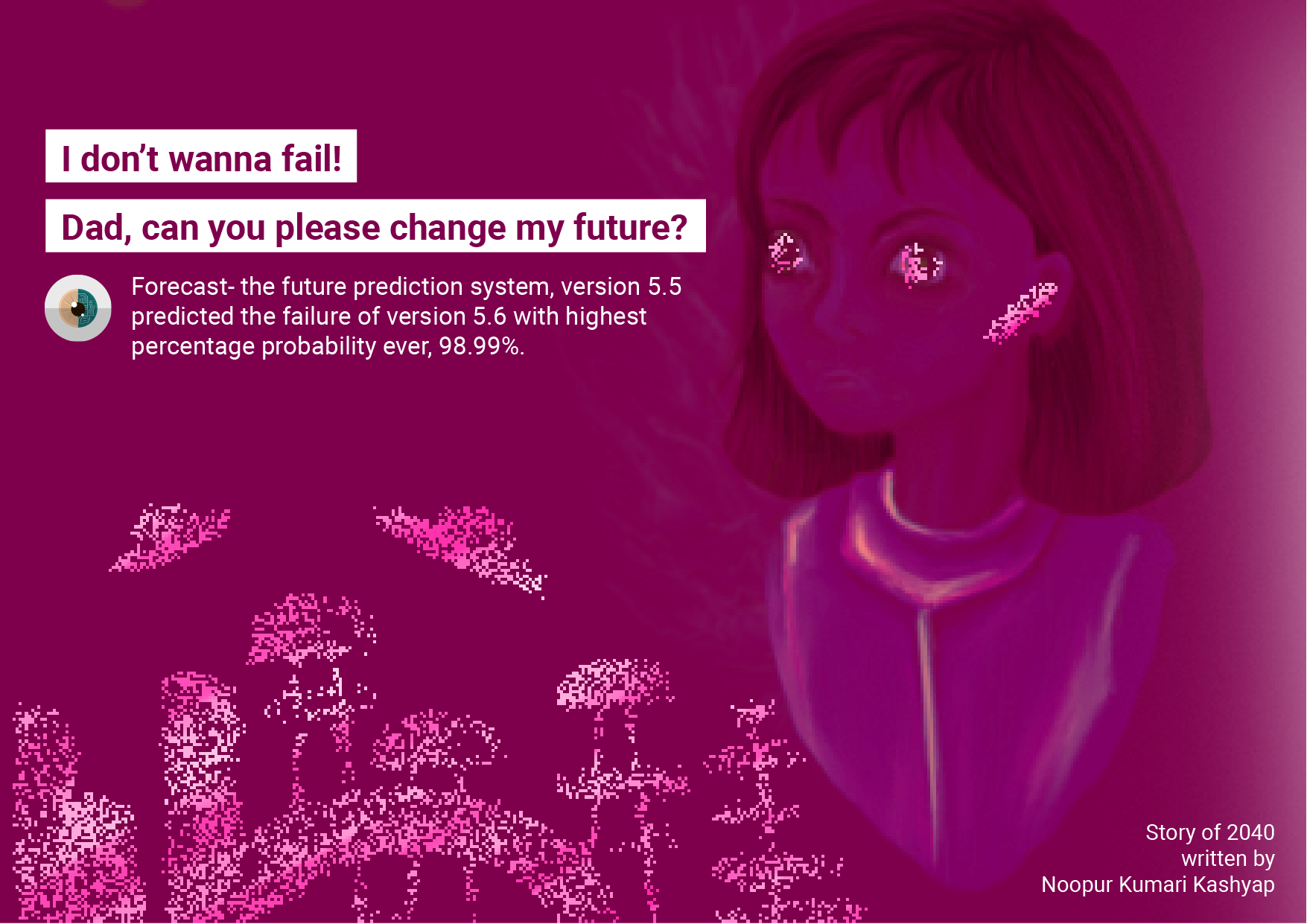
Figure 11
Figures 12(a), (b), and (c) show screenshots of the AR news application. This application covers the entire incident of the VR short film script, as news. It is delivered via the Assitant vision platform in the future. Currently, this application is designed for a mobile platform, as a tabletop experience. And is developed using unity and ARcore.
.jpeg)
(a)
.jpeg)
(b)
.jpeg)
(c)
Figure 12
Learnings & Conclusion
Methods of future predictions have shown changes from the past. In the past when it was considered as a paranormal belief today we have a mix of both, but a modernization to the method is seen. May be predictions were done in caves too. But increasing data about users in the hands of big firms is a reality. If weather predictions and market prediction is a reality today, it is because of the availability of enough data to do so. If data about us increase, our behavior is tracked, then why not information about us can be predicted!
Technology always had two sides and laws are required to govern its power. Advances in technology, change our speculations on how things can be, but at the same time, our thoughts about the future are not limited by technology. It allows us to think about what people want their future to be. Predicting the future allows extrapolation of a general concept or a belief today, to something hypothetically attractive for tomorrow.
References
1. Nostradamus and his prophecies
2. Nostradamus(1503-1566)- article by Robert T. Carrol 27 October 2015
4.Technological Singularity (Wikipedia)
6. Fortune-Telling: Fact, Fiction, and Fantasy by Banjamin Radford, April 9, 2013
8. Making Predictions and reading Comprehensions by Eileen Bailey January 30, 2019
11. How does AI work by silk Otte
13. The house that spied on me by Surya Mattu and Kashmir Hill July 2, 2018
14. Predictive modeling (Wikipedia)
16. ‘The entire History of You’- Black Mirror, Series 1, Episode 3